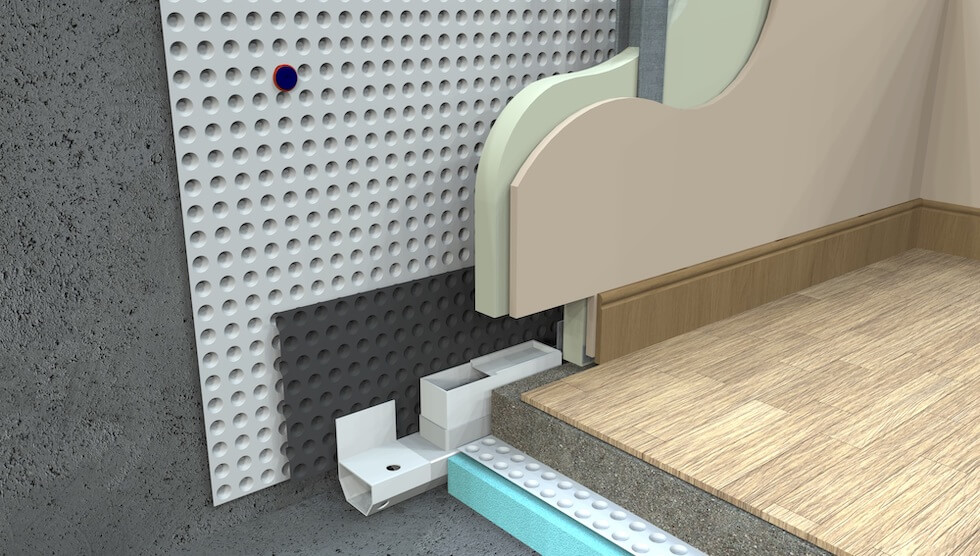01732 496 523
What types of basement drainage solutions are there?
‘Basement drainage’ is a broad term that can refer to the removal of water either as a part of or in order to assist with the waterproofing of the basement.
DOWNLOAD THE FULL ARTICLE HERE ?

Internally, with Type C cavity drain waterproofing systems, drainage is an absolute requirement, whereas externally, when used to prevent water from bearing against the structure, the use of drainage can vary from very helpful, to not so helpful, and in some cases it can actually be dangerous.
The following article explains in detail the different forms of basement drainage and when they should and should not be used.

Internal Drainage Solutions
As the most recommended and most comprehensive waterproofing solution, the Newton CDM System includes a network of CDM BaseDrain drainage channels that play an integral role in receiving water that is captured by the cavity drain membranes.
In this instance, the external elements of the structure should be capable of controlling the rate of water ingress so as not to exceed the capabilities of the cavity drain system. BS 8102:2022 states in section 10.1 that water entering a drained cavity system is regulated by the structure, so defects or elements that might result in unacceptable leaks should be remedied before the system is installed.
Captured water is then safely removed from the property either via a Newton Pumping System, or by safe gravity drainage to a point that is downhill of the basement slab.

External Drainage Solutions
When designing a continuous external waterproofing system such as the Newton Hydrobond® System, a key component is the drainage membrane that can be used in order to both protect the waterproofing wall membranes against damage, and to manage ground water to prevent it from bearing against the primary waterproofing.
The Safe Use of External Drainage
When specifying external drainage, some of the technical areas to consider include:
Basements Built Within Sloping Ground
Basements built into slopes will break into existing watercourses and act as a dam to water that would otherwise have flowed downhill. Any such structure should therefore always use a drainage system around the basement.
Basements Built Within Flat Ground
For such structures it is vitally important that the external drainage does not artificially dewater the ground. As such, a good geotechnical understanding should be obtained following a comprehensive study of the surrounding ground.
The Dangers Of Using Drainage Around Basements
It is generally not good practice to use dewatering as a waterproofing method, as it is impossible to calculate how much water needs to be removed in order to prevent it bearing against the structure. If the water has nowhere to go, groundwater could surround the basement to its full height.
Soakaways are also not necessarily guaranteed to remove water from the ground around the basement, especially if it is saturated. It is extremely difficult to use pumps for dewatering when it is impossible to know how much water needs to be pumped. Overall, if the basement is being constructed within flat or level ground then drainage and Type A waterproofing cannot and should not be relied upon as the only method of keeping the basement dry.
The Dangers of Dewatering With External Drainage
When building within flat, permeable ground, as water is removed it will be replaced by water from the surrounding ground. As this water moves, it brings with it fines from the ground; the smallest soil particles that bind it together. By constantly removing the water and therefore the fines as well, the soil gradually becomes less dense and, if enough is removed, then the ground surrounding the basement can become unstable.
 Why Should Combination Waterproofing Be Used?
Why Should Combination Waterproofing Be Used?
The British Standard for Waterproofing (BS 8102:2022) recommends the use of combined waterproofing systems in order to provide enhanced protection. In cases where the basement is built within a slope, both of the drainage methods mentioned in this article may be installed on the same project to ensure maximum protection.

Guaranteed Waterproofing Installations
Newton highly recommends that installation is undertaken by a Newton Specialist Basement Contractor (NSBC). NSBCs can provide a substantial insured guarantee and take full design liability on the project, fulfilling the role of ‘Waterproofing Specialist’ as recommended by BS 8102:2022.
Customer Success Stories
Our latest customer reviews from Feefo - the award winning review platform

Speak to our friendly, expert team
Our staff are able to provide guidance for projects of all sizes, whether you require some general advice about damp or waterproofing, or support with technical drawings and specifications.














